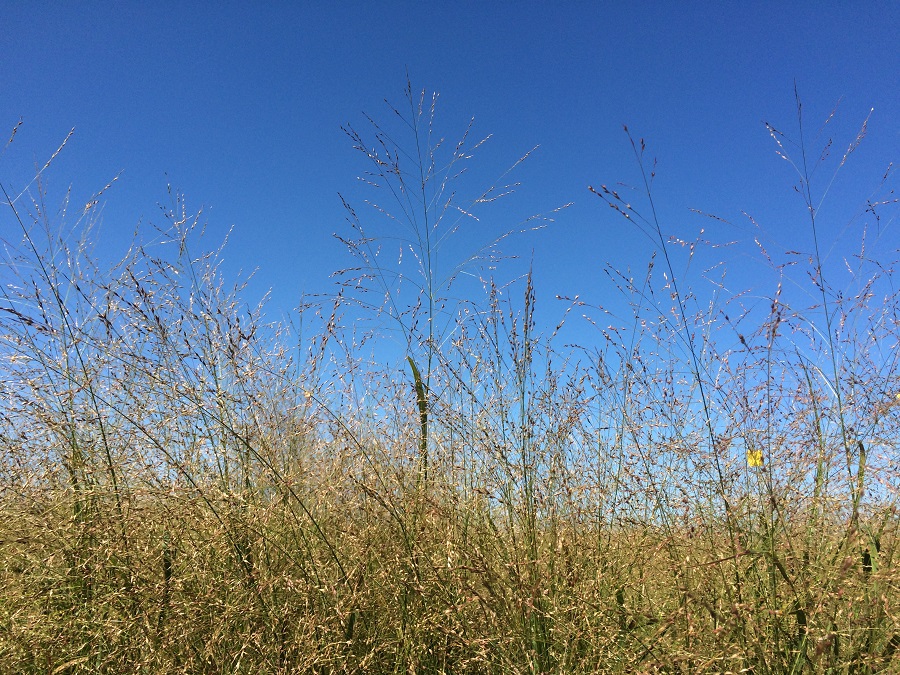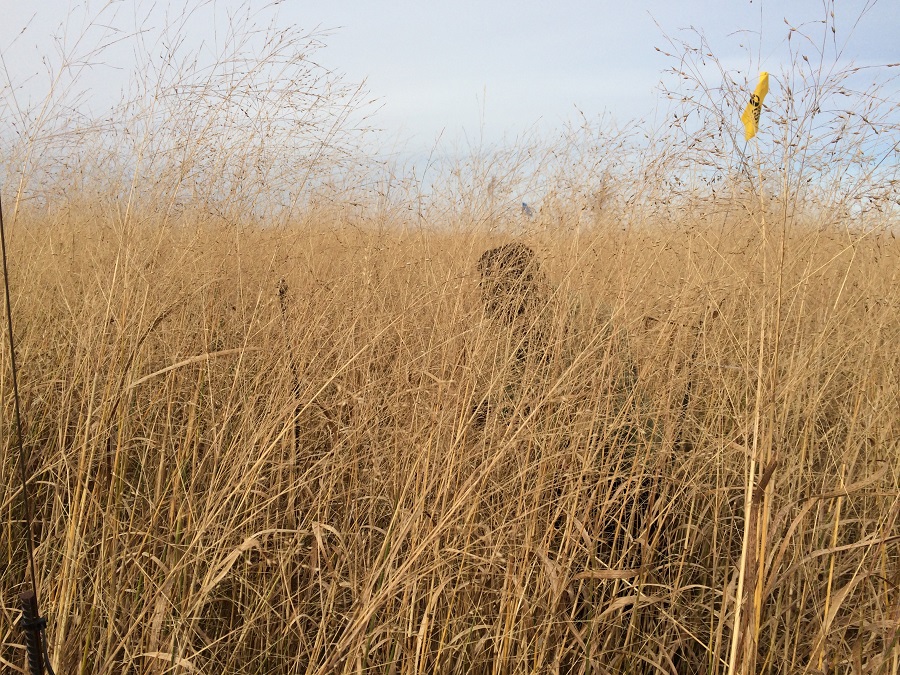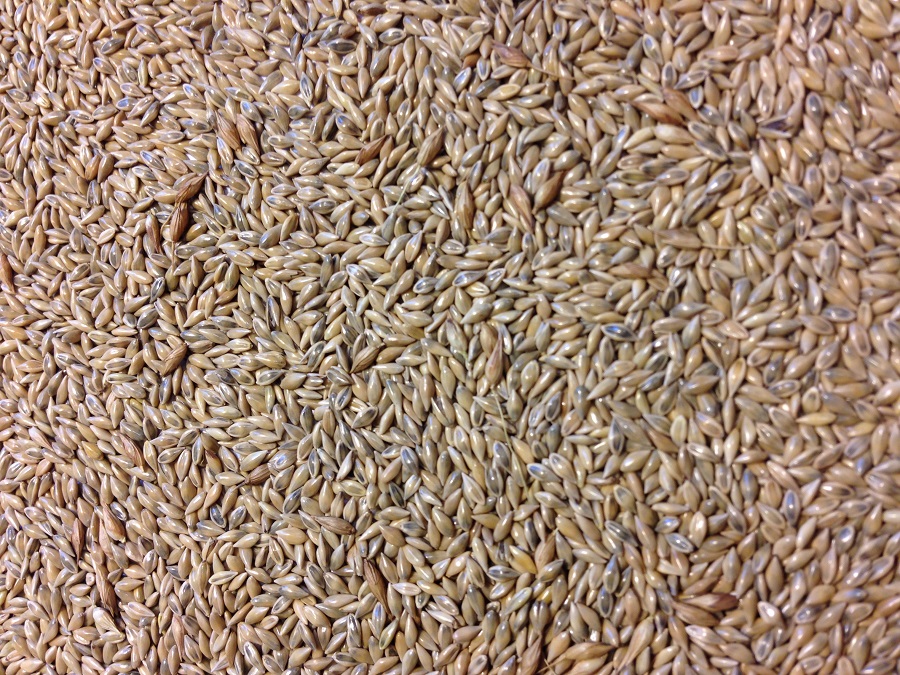Author: Ruth Burke
Spring is here and summer is just around the corner. Not only is this a great time to clean up your garage and air out the house, it’s also the perfect time to get the garden ready, plant your summer food plots, and – in the spirit of this blog – seed your switchgrass stand!
As one of our most popular products this time of year, switchgrass is a versatile, useful, and beautiful native grass that customers are constantly asking questions about. In this blog article, we’ll answer some of those questions by providing suggestions for usage, establishment, and maintenance.
What is Switchgrass?
Switchgrass is a warm season native bunch grass endemic to practically all of North America. As a warm season grass, it flourishes in the warmer months of the year (from about June until September or October) and goes dormant during the winter months. At full maturity, switchgrass can reach a height between 5 and 6 feet tall and, while it is technically a bunch grass, it also spreads by seed drop and underground rhizomes.
The foliage transitions from bright, rich green in the summer months to a golden brown in the fall and winter. The seed head is a large and leggy panicle that adds an almost lacey appearance to the top of the stand when viewed from afar.
Useful for Prairie Plantings, Erosion Control, Wildlife Habitat, and Biofuels Research
Because it is a native grass that is widely adapted across the United States, switchgrass has a multitude of uses. Most notably, although perhaps not as well known, switchgrass has been extensively researched for biofuel and bioenergy applications. A great side benefit of this research is the increased availability and broad selection of switchgrass varieties, both upland and lowland cultivars.
Switchgrass is a popular species to include in prairie restorations and CRP plantings. Although it is best adapted to areas with moderate to moist soils, switchgrass has deep roots and can withstand droughts and dry soils. Its deep and fibrous root system makes it an ideal plant for stabilization and erosion control while its stiff stems act as a barrier to sediment that is carried by wind and water. Because switchgrass is a bunch grass, it also serves as an ideal nesting habitat for many upland game birds, which will nest in the fallen and senesced biomass. Plus, its seeds are palatable sources of nutrition late in the season for all kinds of wildlife.
One of the most popular uses of switchgrass is as a food plot screen or, combined with shorter grasses, as a bedding plot. Once established, switchgrass reaches an average height of around six feet tall and produces a visually impenetrable forest of leafy and stemmy biomass. But this forest is still pliable enough for animals to move through it – making it the ideal screen or bedding area. If used as a food plot screen, we recommend planting it in 10- to 20-foot wide strips to create a visual barrier. If planted in a mix with shorter grasses as a bedding plot, we recommend a 1/2 acre if surrounded by woods and other habitat and larger acreages (one or more) if surrounded by cropland.
When is the Best Time for Planting Switchgrass? Should I Fertilize When I Plant?
As a warm season grass, switchgrass thrives in the heat of summer but goes dormant in the cold winters. In order to germinate, it needs the soil to be 55 degrees Fahrenheit or warmer. For previously stratified seed, it is best seeded in mid-spring (in the Upper Midwest). However, for seed that has not been previously stratified, switchgrass germination can be improved by planting it in late winter or early spring.
Deer Creek Seed’s switchgrass seed has not been stratified and therefore roughly 25 percent of the seed will be “hard” and won’t germinate until the following year. To eliminate this delay, simply frost seed our switchgrass in the late winter or early spring instead.
What is stratification, you ask? Well, native plants often have lower germination rates because their seeds are “dormant.” Dormancy is an effective survival mechanism that prevents seeds from germinating too soon or from germinating in environments in which the seedling may not survive. In this instance, a great way to break switchgrass seed dormancy is to frost seed, which exposes the seed to the natural freeze/thaw cycle that seed would have gone through by dropping to the ground the previous fall. This process is known as stratification.
As far fertilization during planting is concerned, switchgrass is a slow grower in its first two years so weed competition will be fierce. We recommend getting a soil test before seeding and applying any necessary phosphorous and potassium either before or at seeding. You should wait to apply any necessary nitrogen until the seedlings are at least four inches tall (so that you aren’t encouraging weed growth right off the bat!).
If you don’t live in the Upper Midwest, we’ve included additional resources at the bottom of this article that give recommended seeding times for other regions. You can always check with your county NRCS office or local university Extension office as well.
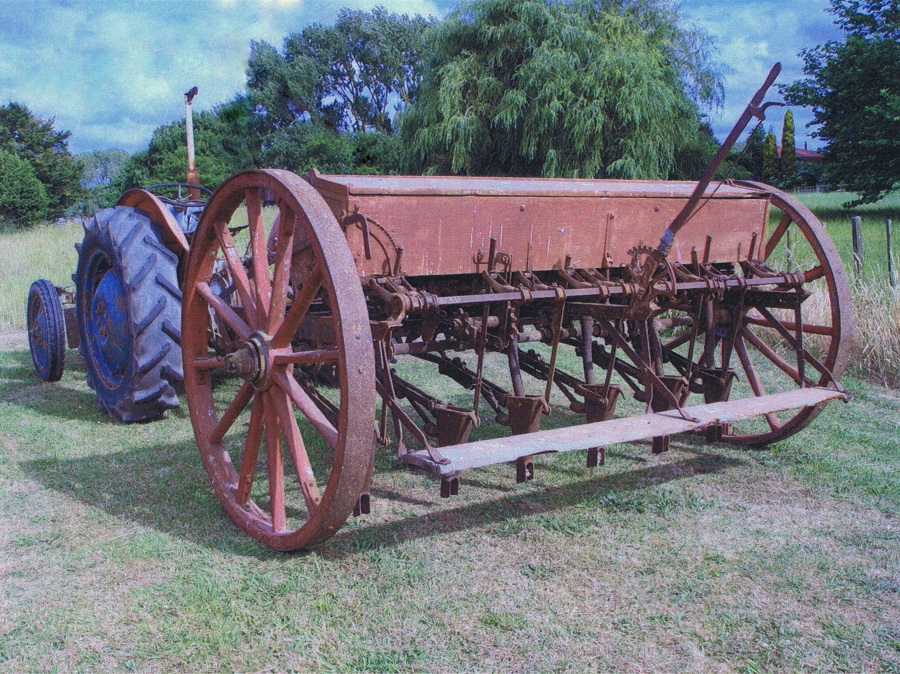
(Okay, this is a vintage grain drill...we don't expect you to use one of these!)
How Should I Plant Switchgrass?
While there are many ways of planting switchgrass, the most effective will be drilling or no-till drilling into killed sod. Drilling ensures sufficient seed-to-soil contact and covering and no-tilling into a killed sod will ensure weed suppression while the seedlings take off.
You can also broadcast switchgrass seed, but it is better to do this in the late winter or early spring to take advantage of some of the freeze/thaw movement into the soil. We recommend increasing your seeding rate if you broadcast and dragging/rolling afterward to improve seed-to-soil contact. For additional seeding information, see #1, #2, and #4 in our list of additional resources below.
What is the Seeding Rate? And What Does PLS Mean?
Okay, so we’re going to talk a little math here! But bear with me, because switchgrass is worth it! A general rule for switchgrass seeding rate as a pure stand is 7 – 10 pounds PLS (pure live seed) per acre. If you’ve spent any time at all seeding native plants in the past, you will have run into the “Pure Live Seed” qualifier for seeding rates. That is simply a method of ensuring a certain level of germination – because natives often have seeds that are dormant in their first year of seeding. Pure Live Seed rates are calculated as follows:
Percent (%) Purity x Percent (%) Total Germination / 100 = % PLS.
Ex: If you have a bag of switchgrass that is 98% pure and has a germination percent of 85%, then your percent PLS is 98 x 85 ÷ 100 = 83.3% PLS. If you purchase a 10-pound bag of this switchgrass seed, 8.33 pounds will immediately germinate after planting and 1.67 pounds will remain dormant until after the first year.
Currently, Deer Creek Seed sells our switchgrass in bulk pounds. Therefore, we recommend a “rough” conversion factor of 1.2 when figuring out how many pounds to order.
Ex: If you need 21 PLS pounds of switchgrass (3 acres at 7 pounds per acre), multiply 21 by 1.2 for the total number of bulk pounds you should order. In this case, you would order about 25 bulk pounds of switchgrass.
In reality, you don’t need to worry too much about the PLS (pure live seed) concern. The switchgrass seed that you would order from Deer Creek Seed will grow just fine – but there may be a certain percentage that won’t germinate until next year. That’s the beauty of native seeds! They’ve developed long-term survival mechanisms like dormancy which ensure they can live a long time in the wild.
Deer Creek Seed is also going to change how we sell our native grass seeds. Starting the spring of 2019, our native grass seeds will be packaged as PLS pounds so that our customers know they are receiving at least one pound of seed that will germinate in the first year of seeding.
Is Switchgrass Sensitive to Herbicides? How do I Control Weeds?
Because switchgrass is a perennial plant (great for landscaping and for deer bedding around perennial food plots), you should know it will be difficult to control weeds once the grass is established. Herbicides will kill weeds, but they can also damage the switchgrass stand. It is also important to remember that switchgrass is a slow grower, so weed control is very important in the first two years of growth (and we’ll talk more about that in a few paragraphs).
A general plan to follow is a two-step weed treatment plan. Treat the planting area with a non-selective, broad spectrum herbicide. If you are no-till drilling, you would proceed with planting at this point. Make sure that you wait to exceed the appropriate carry-over interview before seeding (check the herbicide label for this information).
If you are drilling or broadcasting into a clean bed, prepare the site as you would for planting and allow a two-week window for additional weed growth. Once the weeds have reached approximately 2 to 4 inches in height, treat them again with the herbicide. At this point, you will be ready to seed your switchgrass. For additional weed control recommendations, see #1, #2, and #6 in our list of additional resources below.
Getting it Off the Ground…Handling Weeds in The First Two Years.
As previously stated, switchgrass is vulnerable to weeds in its first two years of growth because it is a slow grower. Frequently, folks will assume that their switchgrass stand was a failure because they don’t see much growth in the first year – don’t assume this! Depending on where you live, switchgrass most likely won’t flower (form a seed head) until its second year. It also won’t get very tall. But don’t let that fool you. By the third year, as long as you’ve properly managed the site, you will have a robust stand!
How do you properly manage the site? Honestly, clipping (mowing) is the best way to stay on top of weeds. In the first two years, mow switchgrass stands to a height of four inches in May or about six inches in mid-summer (June or July) to allow enough time to grow back before winter dormancy. If you live in a climate with a longer growing season, you could mow the stand once more, but make sure to allow a 30 to 45 day growing window before the first hard frost.
Depending on the size of your stand, you could spot treat any particularly worrisome weeds with a broad-spectrum herbicide. Be aware that this could damage your switchgrass and you may need to re-seed that particular area.
Also, native grasses (in general) do not need large amounts of fertilizer. Unless you have a soil test that calls for additional fertilizer needs, it is best not to supply heavy quantities because you will only be feeding the annual grassy weed population.
While the first two years may seem a little labor-intensive, it will all pay off! Switchgrass takes off by its third year. It is an aggressive grower that will choke out most weeds and will thicken and spread to create an impressive stand for whatever end-use you are looking for.
Which Switchgrass Varieties Should I use?
As you delve into looking for switchgrass seed, you will discover that there are several varieties or cultivars of switchgrass available. Deer Creek Seed sells three switchgrass varieties: Cave-In-Rock, Dacotah, and Forestburg.
While these cultivars are upland cultivars and will grow best in the upper Midwest, they will also grow just fine in southern states as well. However, you may be interested in finding switchgrass varieties more specific to your area – if that is the case, we recommend that you contact your county NRCS or local university Extension office for more varietal recommendations.
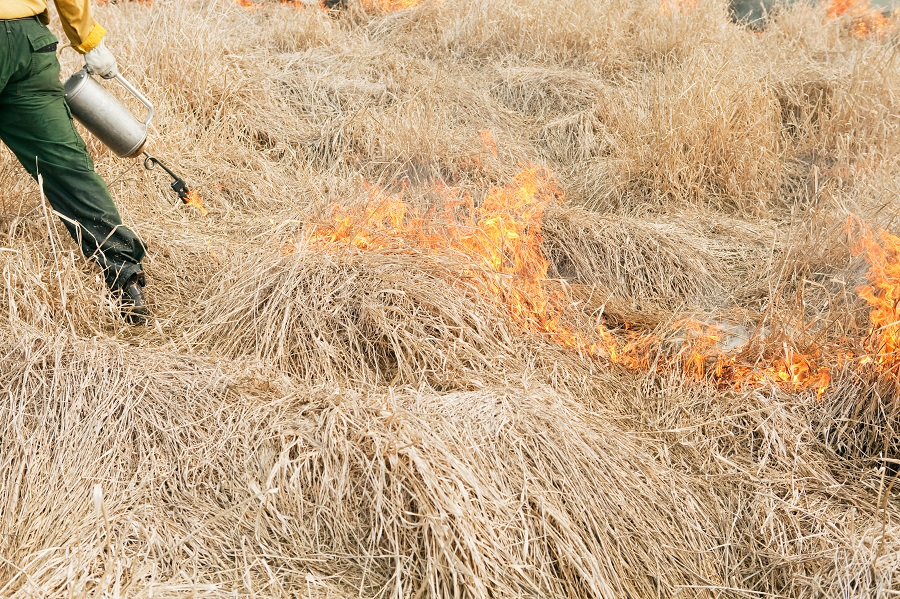
Long-Term Maintenance
Switchgrass stands are relatively low-maintenance after the first few years. One important aspect of switchgrass (and all native grasses) is that they evolved under the pressure of both prairie fires and bison herds.
Native grasses developed life-cycles that benefit from occasional burns and/or complete grazing events. In general, bison herds are hard to come by nowadays. So, as a fall back option, it is a good idea to burn your switchgrass stand every 3 to 4 years.
If you’re growing a larger stand for upland game bird habitat, we recommend sectioning your stand into thirds and burning each third every year (so you basically burn each section every three years). This will protect nesting birds and allow for refuge. For great resources on conducting prairie burns, see #5 and #8 in our list of additional information below!
It’s a Slow Build, but Worth the Wait!
Establishing a switchgrass stand isn’t the hardest thing to do in the world – but neither is it for the faint of heart. You need to be willing to put in some dedication in the first couple years to making sure it gets a strong start, but after the initial effort, it will more than repay the work you put into it!
Switchgrass has a passionate following of acolytes (this author is one!) who will wax poetic and sing praises for the versatility, beauty, robustness, and efficacy of this grass as a multi-purpose and valuable addition to any landscape. If you would like to find additional information about maintaining or planting switchgrass, visit one of the many resources I’ve included below. Happy spring and happy planting!
Sources of Additional Information
1. The USDA NRCS has created a general switchgrass plant fact sheet, which includes suggestions for establishment and management. They’ve also written a planting guide that gives additional agronomic recommendations for planting switchgrass.
2. The Pennsylvania NRCS released a great article on establishing native grasses. This guide was meant to provide direction for folks participating in a CRP program, but it has information that is useful for anyone planning to install a native grass stand.
3. The Missouri NRCS published this article on ‘Cave-In-Rock’ Switchgrass, one of the more popular switchgrass varieties for wildlife nesting and screening plots.
4. The Tallgrass Prairie Center at the University of Northern Iowa created this great guide to seeding native prairie grass seeds, including machinery recommendations.
5. The National Wild Turkey Federation has a simple guide to establishing native warm season grass for upland wildlife. They include ideas for burning schedules to better preserve nesting habitat and offer suggestions for herbicides.
6. The Arkansas NRCS developed this succinct guide to establishing native warm season grasses that may be better suited for folks down south.
7. For more information on calculating Pure Live Seed (PLS) rates, the USDA NRCS has developed a great PLS Info sheet on the subject.
8. Michigan DNR developed a great guide on prescribed burning! You can also contact your county NRCS or Extension office for more information on controlled burns.



